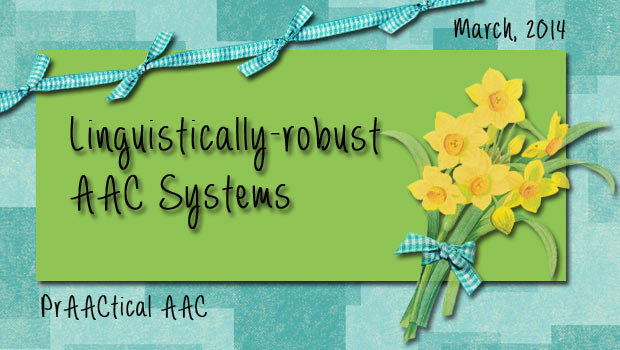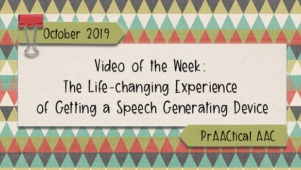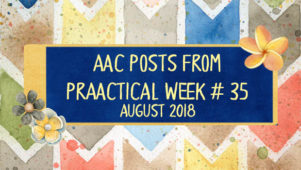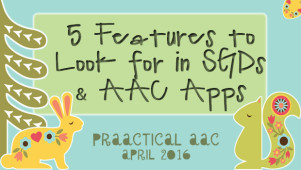Linguistically-robust AAC Systems

At the NCACA conference last month, a few of us were talking about what it means to have an AAC device or app with a strong language system, something Gail Van Tatenhove and I wrote about a few years ago in this book. Linguistically-robust language systems are those that will allow someone to construct grammatically correct utterances. Think of the different SGDs or AAC apps that you worked with this week. If you could use them to recreate the last 30 minutes of ‘talk time’ that you had without spelling out too many of the words, chances are pretty good that it is a linguistically-robust system.
That led to us asking ourselves and others a question. “What do you look for in terms of a language system when you’re considering SGDs or AAC apps for a learner who has the potential to (eventually) construct grammatically correct utterances?” Keep in mind that we were not talking about other aspects that factor into device selection, such as access, speech, rate enhancement, or symbol type. Instead, the focus was on the specific linguistic characteristics that give us the platform for teaching generative language.
Here is the list of language features on which there seemed to be consensus.
- No fewer than 300+ core words
- Wide range of word classes (e.g., verbs, pronouns, modifiers, conjunctions, prepositions)
- Ability to make morphological changes (e.g., tense, pluralization, comparative/superlative)
- Supports motor automaticity but allows for planned growth
- Text-to-speech
- Word prediction
What’s your ‘minimum criteria’ for a linguistically-robust AAC system? We’d love to hear your thoughts. If there are language features that you find essential that we omitted, we’d love to hear about them. Agree or disagree with our list? Suggestions? Let’s discuss!
Filed under: PrAACtical Thinking
Tagged With: generative language, SGD
This post was written by Carole Zangari





6 Comments
Hi Carole,
I think this is a great conversation to have and I’m pleased that you opened it up to a community discussion. When I was reading your post, it made me think of how we could broaden that definition and add a few more “essentials” to that list.
I will include a few references at the end but there is research, from both linguistics and AAC, that demonstrates a significant part of what we say is not novel. Instead, it is made up of utterances we have previously used with one or several words that change. Even young children use consistent chunks of language in which they modify a word or two based on the situation/need.
These chunks don’t cover everything we say, however. We still need access to single words and keyboards to fill in or say something completely novel. As verbal communicators, our linguistic knowledge includes a combination of pre-programmed messages and vocabulary to create novel messages. I believe we should offer this same opportunity to our AAC users as well.
Much of the way I think about this topic has been informed by research. Some of the references I give below show that as communicators we require a combination of formulaic (pre-stored) and creative (core and spelling) strategies to ensure we can communicate what we want both efficiently and precisely. And the idea of efficiency and precision is definitely a linguistic characteristic.
So maybe we could consider adding to that list:
• Access to pre-stored phrases
• Availability of commonly used utterances
• Efficient switching between pre-stored messages and core/keyboards.
I wanted to try to keep this post short but I’m not sure I succeeded :-)
I also want to disclose up front that I am an SLP who works for DynaVox.
Thanks so much,
Patrick Brune
Thanks so much for those comments, Patrick. We couldn’t agree more that for an AAC system to be effective, there has to be prestored messages to improve efficiency and reduce effort. The balance of effort versus payoff is one that we don’t always think about as much as we should. We’ve written about the ways in which we use pre-prepared messages but not really about the integration of the two, which is something that probably needs to be fleshed out. Interestingly, I had a hard time selling this point recently to a young woman who has been using a core vocabulary approach for many years. Now that she is gaining a little experience with prestored messages, I think we are winning her over. 🙂 Thanks again for this thoughtful contribution, Patrick. Hope all is well. Come see us next time you are in the area. 🙂
I like the feature that affords the ability to EASILY hide and unhide words, so you can support motor automaticity while learning new words and systematically add new words without affecting the motor plan of words that have already been targeted..also the ability to unhide words also provides the ability for important exploration time..”playing with words”
Mary Beth, that feature has made life SO much easier, hasn’t it? I also really love the ‘tutor’ feature that will show you the path to get to a word if you spell it out. I first started using that on Delta Talkers, if memory serves, and it was one of those things that boosted my learning and the client’s as well. Thanks for sharing that.
Sometimes the see-saw of AAC heavily leans towards core words, and they are vital, but pre-programmed messages are also a key part of a robust AAC system.
Question: What parts of this list remain for low-tech AAC systems, and what parts would be different? I’m thinking of paper-based options like PODD books, core boards, etc. Are there any that you think are robust, or are heading that direction?